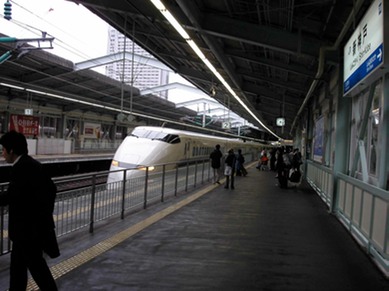Monday, 7 April 2008

It was a case of rise and shine relatively early for the first day of the Japan Rail Pass big travel week, and no sooner had ‘Er Indoors checked out (by machine, a process completely devoid of human influence on the business end) than we were heading off in search of the subway station that would begin the day’s journey.
I hadn’t actually seen the sort of crowding that people tend to associate with rush hour Japanese subway travel up to this point. You know what I mean, those images of heavily built railway staff on hand to push a few extra passengers into a sardine-packed carriage.
The heavily built people pushers were conspicuous by their absence when we arrived on the platform, joining perhaps a dozen people waiting for the next train. The arrival of the train, however, suggested they’d been needed further up the line. The carriages were packed and it was with difficulty that we made our way towards the carriage against a flood tide of black-suited salary-men.
And, once the previously packed compartments had emptied we found ourselves almost alone in a strangely deserted carriage.
Of course, we were headed out of the city centre, towards Shin-Kobe Station, which is, like many of the shinkansen depots, located slightly away from the main commercial and business area of Kobe.
We arrived with plenty of time to spare, which allowed us to enjoy a leisurely breakfast before it was time to board the 8:25 service to Kyoto.
Having grown up in Queensland where the trains operate at a much lower level of intensity I’d been warned that the 8:25 train means the one that actually leaves at 8:25 and will arrive, more or less at eight-twenty-three and a half, being a completely different conveyance to the 8:22 which leaves the same platform for, more than likely, a completely different destination.
I’d become accustomed to the guide lines on the commuter rail platforms, but at most shinkansen stations there are barriers with gaps where the train’s doors will open.
And, amazingly, that’s exactly where they do open, and you’ve got about a minute and a half (if that) to get on board and locate your seat before you’re off.
We talk about bullet trains but there are actually three levels of service on the Tokaido/Sanyo shinkansen lines
The fastest, Nozomi (hope or wish) are, more or less, extreme express affairs, stopping at a handful of stations and aren’t covered by the Japan Rail Pass, so there was no way we were going to be gracing one with our presence on this trip, which was a pity since they’re capable of covering the 515 kilometres between Tokyo and Osaka in two and a half hours.
The intermediate level Hikari (light or ray) services stop at a few more stations, usually to allow the faster Nozomi to pass.
The slowest Kodama (echo) services stop at all stations, allowing faster services to pass through.
Once aboard Hikari 364 Thunderbird 7 (impressive name, or what?) the first section of the journey took us through a tunnel, emerging onto a viaduct comfortably above the surrounding conurbation. Faced with obstacles like hills, the shinkansen services go through rather than over them. If the obstacle is a built up area the solution is, predictably to go over rather than through.